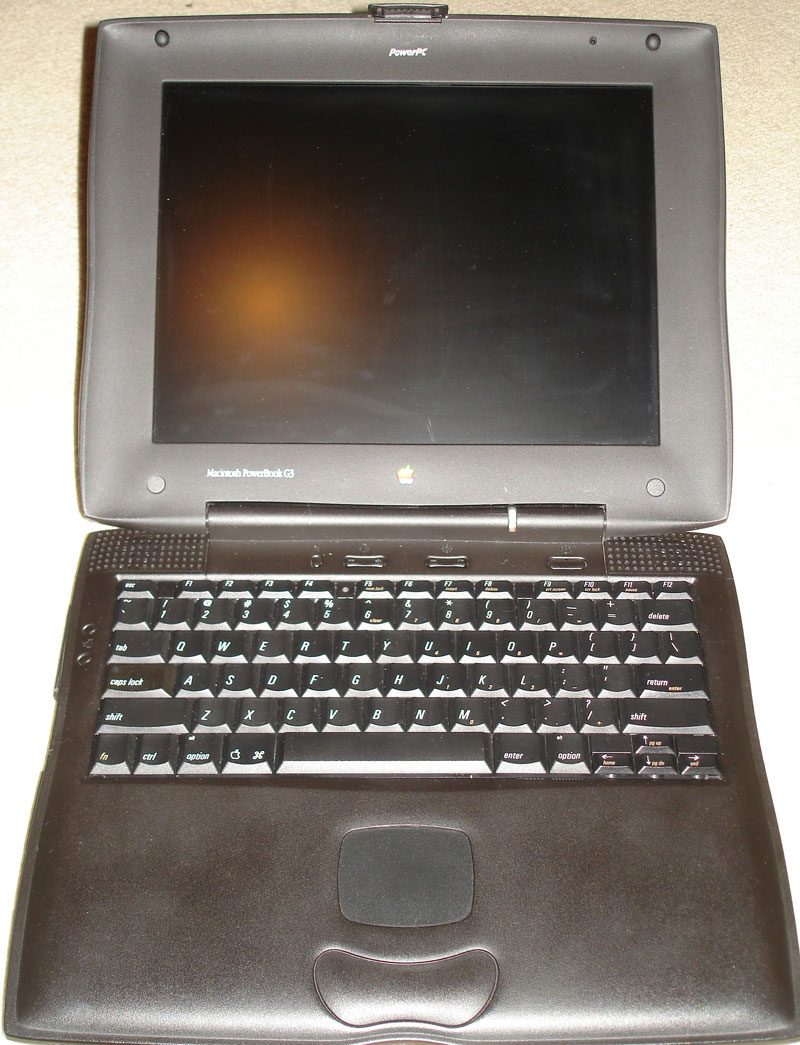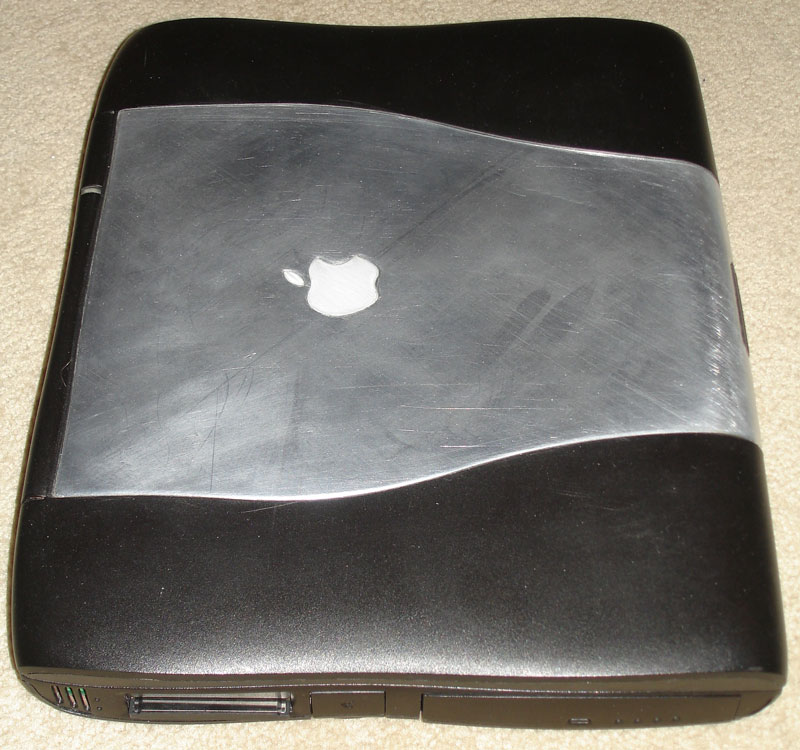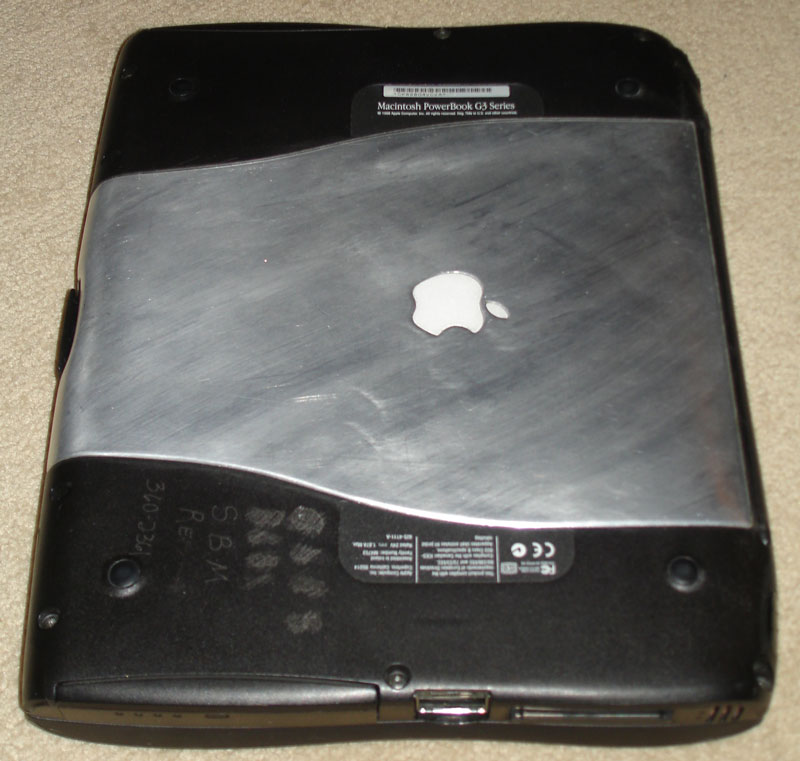G3 Wallstreet
From Sfvlug
This laptop was found by a member of SFVLUG and given to DualDFlipFlop to modify and configure for general use.
This is a Powerbook Macintosh G3 "Wallstreet". This system was released in 1998, and was the last of the "Old World" ROM. Which means that it is technically not capable of booting OSX or any other operating system without OS 9 boot.
Contents |
SO WHAT DO WE HAVE HERE
Apple System Profiler
Let's see what we've got.
Operating System
- Software overview ----------------------------------------------------------- Mac OS overview Finder: 9.2 QuickTime: 5.0.2 System: 9.2.1 US CarbonLib: 1.4 Active enabler: None File sharing: is off Multiple Users: Not installed -------------------------------------------------------------------------------
Well, it's quite obvious that CarbonLib is going to need upgrading. We can go as far as to updating the OS to 9.2.2 but the only real reason for that update was for a few forward compatibility issues.
Memory Info
- Memory overview ------------------------------------------------------------- Disk cache: 5120K Virtual memory: 161 MB Used on volume: Wallstreet Built-in memory: 160 MB Location Size Memory type Bottom 32 MB SDRAM DIMM Top 128 MB SDRAM DIMM External L2 cache: Not installed -------------------------------------------------------------------------------
Interestingly enough the top slot has 256 MB and the bottom slot has not yet been confirmed, however it was reported to have another 256 MB. We'll check that later.
Basic Harware
- Hardware overview ----------------------------------------------------------- Machine ID: 314 Processor info: PowerPC G3 Model name: PowerBook G3 series Machine speed: 233 MHz Keyboard type: Apple Standard Keyboard Attributes: DVD decoder present -------------------------------------------------------------------------------
So, this is basically the speed of an iMac Bondie, with a DVD and MPEG Decoder.
Networking
- Network overview ------------------------------------------------------------- Ethernet built-in Link: n/a Speed: n/a Duplex: n/a LocalTalk built-in n/a n/a n/a Modem Name: K56flex [56,000 bps] Protocol: K56flex Version: v1.200 Data/V.17 [14,400 bps] Fax Status: Information gathered. Open Transport Installed: Yes Active: Yes Version: 2.7.7 AppleTalk Installed: Yes Active: Yes Version: 60 File sharing: is off This network: 0 Default AppleTalk zone:Not available This node: 1 Active network port: Ethernet built-in Hardware Address: 00.05.02.8d.da.71 LocalTalk built-in Router: <not available> TCP/IP Installed: Yes Active: No Version: 2.7.7 Personal Web Sharing: is off USB Printer Sharing: Not installed Multihoming: is off Netmask: <not available> Default gateway address: <not available> IP address: <not available> Domain: <not available> Name server address: <not available> -------------------------------------------------------------------------------
This is what the system looks like when it's unplugged, I know it looks messy and empty, but filling in the blanks is very easy.
Apple ID
- Production information ------------------------------------------------------ ROM revision: $77D.41F5 Serial number: Not applicable Software bundle: Not applicable Sales order number: Not applicable -------------------------------------------------------------------------------
Isn't that something... It's totally unmarked, software wise.
Devices Tab
DVD-ROM drive
Driver version: 1.4.7
Mac OS partitions: 1
Expansion Bay 1 Removable media: Yes
ID = 0 Vendor: MAT****A
Revision number: AC1b
Product ID: DVD-ROM SR-8182
Serial number: Not available
Hard drive
Driver version: 3.2.8 Wallstreet
Mac OS partitions: 1 Volume format: Mac OS Standard (HFS)
Internal ATA 0 Removable media: No Capacity: 1.49 GB
ID = 0 Vendor: FUJITSU Available: 687.67 MB
Product ID: MHK2060AT Percent full: 55
Revision number: DA36 Write protected: No
Serial number: 01076717 Is being file shared: No
Size: 6 GB (1K = 1000)
Capacity: 5.59 GB (1K = 1024)
Display card
Card type: display Display
Card name: ATI,264LT-G Screen Size (pixels): 800 x 600
PCI Slot E1 Card model: ATI,LT-G Grays/Colors: Thousands
Card ROM #: 113-XXXXX-1.0028 Resolution (dpi): 72 x 72
Card revision: 128 Additional Information: Main screen
Card vendor ID: 1002
Notice the true capacity of the hard drive, then look at the capacity of the "Wallstreet" HFS partition. This is because later we will attempt to install Linux. Ok, so now we know a little bit about this system, without even lifting a screw. What's next?
HARDWARE MODIFICATIONS
You knew it was coming...
Face Lift
So, since this is a Wallstreet, not a Pismo or a Lombard, I have a few modification options as far as making it look cool! I have a few pictures for you to review
How this was done
I am a frequent visitor of Applefritter and use some of their user contributions has guides to give me ideas on what I can do with some of my Apple gear. This was a perfect opportunity to mimic one of the listed "hardware hacks" which fit the bill for this Wallstreet. This one is called "Perplexed G3" by Tom Owad. Here is a link to refer you to the page I read: AppleFritter Wallstreet Mod
Here are the bullet points of doing this mod:
1. Acquisition - Home Depot was my friend for this one. a. Mineral Spirits - This will be used to dilute the rubber to make it easier for it to be removed. b. Masking Tape - I like to keep things clean, so I use a lot. c. Steel Wool - There are three kinds you want. 0000 , 000 , and 1. d. Foam Paded Sandpaper - This is a good way to get a lot of the rubber off quick. e. Shop Towels - You will need quite a few, some for protecting and masking, and some for wiping the junk off. f. Baby Oil - You'll see... g. Razor Blades - Touch up work, cutting masking tape, killing yourself... 2. Preparation - Take your time. You don't get second chances. a. Masking - As I said, I like to mask heavily, I would also suggest masking off the Apple Logo, don't worry if it comes off later. Use a shop towel to plug up the empty slot bays, and one to cover the screen in case any mineral spirit gets in. b. Apply Mineral Sprits - Liberally, and I mean extra liberally... This stuff is great, you won't hurt the plastic, but this stuff practically melts off the rubber. However, you will be spending a lot of time scraping it off. When it gets dry, apply more. I almost went through a whole bottle. 3. Action - Getting you hands dirty. a. Once you have drenched the rubber in mineral spirit, you may want to start hitting it with a really rough grit sand paper, you will notice when the black comes off, there is another coat which is a light greenish yellow color. b. When you get to this point, you will want to move to a finer but still coarse steel wool like a #1 or #2. Take it off until you get to the metal. c. At this time, you may want to also start thinking about the edges and sides. I found that a razor blade and a fine touch can scrape off and touch up the edges nicely, however, you may want to also use the edge of your sandpaper as well to get into the crevices. d. Once the metal is mostly exposed, move to the #00 or #000. e. When you have all the metal exposed, it is up to you how you want to touch it up. I prefer having a brushed metal look, rather than a fine polish. The shiner you want it, the finer the steel wool. I think you can get down to #0000 or finer, but trust me... If you just use a #000 and rub in a diagonal direction, it'll look pretty slick. 4. Cleaning up - So you don't look stupid. a. Dry off the laptop and remove the masking b. Brush off any excess dirt or grime with diluted Simple Green or light rubbing alcohol. c. Take a clean rag, and apply a very light coat of baby oil to all of the plastic to restore the luster and make this laptop look new!
That last baby oil trick is actually great on any plastic to restore it. Make sure you have a clean and dry laptop before you apply it, or you'll generate spots. Also, don't use too much baby oil, you don't want this sucker to slip out of your hands, or make you look like a pervert.
DEALING WITH Mac OS 9
Backing Up
This machine does not have USB, that came out with the next version. However, it does have a SCSI interface, and can boot from it. This provides an easy way for me to store my other programs from previous installs and other systems. Usually Mac does not require an installer, so dragging and dropping a program directory will do the trick. This is also true with full hard drive backups. The system was pretty clean, and had no programs that I didn't already have, so I continued to format and partition.
Partitioning and Formatting
I then boot from CDROM, if you have a backup of a fresh install of OS 9 and all the programs you want in the system, there is no need to reinstall from the CD, all you need is the Disk Utilities to format and partition the drive. This also means, you can use any bootable media you have to do this action, otherwise, you should really go with OS 8 or 9, and upgrade to 8.1, or 9.2. I rarely go over 1.5GB of space, so I chose 1.5GB Macintosh Standard (HFS) as my filesystem and partition size. I could have gone with HFS+, however I had problems before with mounting read/write on Linux. When formatting, I selected the write all zeros to the drive choice. This is because I want a totally clean hard drive when I install Linux.
Restoring the Backups
With the machine still booted in the OS CDROM and the SCSI drive still attached and mounted, I literally just copied and pasted the system folder, application folder and such, back over to my laptop hard drive. Sure this will take time, backing up, formatting and restoring. For me it took 10 min for full transfer either way. On another note, do not get rid of your backup. This is because you may need to use it again in the event of something going wrong.
Okay, let's move on.
THE ADVENTURE OF LINUX
This part really messed with my mind. I had flashbacks of the days when Linux was actually hard to install, somewhere around pre 1998 or so.
First Attempt
I started with Ubuntu PPC, here is my reference: Wallstreet G3 Ubuntu Guide
I had a copy of 5.04 PPC that was acquired back during SCALE. And this is what I used for my first attempt. This is the root of my first problem.
Now... Remember how this system is "Old World" and can't boot just any ol' operating system. Well, this means we need a boot loader for Mac OS. The one that works for this particular machine and OS is called BootX. I have to insert the CD of my Linux installer CD and copy the vmlinux and initrd.gz files into my system folder a certain way and select them in the BootX menu.
Well, while I was off doing something else, Devon ended up wiping my drive clean to do this, erasing my previous OS 9 install then having to go through the hassle of having to toss his ass copy of OS 9 from back in the day on a 1.5 GB partition (what a jerk). This is why I said to keep backups, luckily I did. Since my backup wasn't present at that moment, we had to transfer his old OS 9 files from his iBook on the drive and do this little song and dance, reinstall BootX.
For the most part BootX worked, except since I didn't have the correct video mode at the time, I wasn't able to just waltz in there and shift to the console to mount the HFS partition and toss the vmlinux and initrd.img files into the system folder once I finished the install. So what did I do? Grabbed an IDE to USB controller, mounted the ext3 partition from an OSX iBook Devon had at the time we where doing this. That didn't work... So we used a Knoppix CD to boot from one of the HP machines in the lab. Here is where the uber micro came in. The keyboard didn't work on the HP. Go figure. So, instead of switching computers, we decided to copy and paste each letter from the Knoppix homepage using Firefox to the console like pro's. Then mounted the drive and tossed it on my USB stick. Once we got the files off the USB stick and tossed it on the OSX iBook, we mounted the HFS OS 9 partition on the my laptop drive.
All this, to get the boot images in the System Folder... Wonderful. And to think, if this worked I wouldn't have had to do all the above:
cd /target mkdir hfs mount /dev/hda[os9part] hfs -t hfs echo '/dev/hda[os9part] /hfs hfs defaults' >> etc/fstab cp boot/vmlinux hfs/System\\ Folder/Linux\\ Kernels/vmlinux cp boot/initrd.img hfs/System\\ Folder/ramdisk.image.gz
So, now that I can boot into the Ubuntu installation, using an external CRT to help me with the screen issues, which helped somewhat. I go into the file system only to find that Ubuntu didn't finish installation, and needs help.
Doing a little more research online about what my installation issues where all about, I couldn't find anything, but I did manage to figured out the video modes from trial and error: Mac Video Modes for Linux
Second Attempt
This is getting on our nerves. Using the same principals provided by the notes in the reference link, we attempted to install Ubuntu 5.10 after downloading it from their mirror site.
This time, the installation went smooth, the forced video arguments worked well, however there are still a few noticeable glitches in the screen, perhaps that can be tweaked later. Switching to console mode to get the boot files into the System Folder.
Long story short... It didn't work, the same issue happened where I get tossed to the ash shell.
Third Attempt
This time, I decided to download Debian PPC straight up. I got into the install just fine, however for some reason, the installer doesn't have the HFS filesystem to use for me to copy the required files over to where it needs to go in the System folder on the OS 9 partition. So there is no way I can get this on using the mounting procedure. And I'm not about to do the same thing I did in the first try. Screw it.
BACK TO OS 9
Old School Hacks
So in the frustrations with getting Linux on an "Old World" system, I decided to focus more on my OS 9 1.0GB partition. Before going on a trip, I burned a CD containing a bunch of old school script kiddy tools, phreaking programs, encryption utilities, and other general purpose networking and debugging tools, along with a bunch of old text files related mostly to Mac Hacking. With plenty of room left, I added a bunch of media files as well, mostly .mp3 music and some pictures I wanted for backgrounds. I was set! I started testing out a bunch of the software alphabetically and found that most of it was superfluous and ended up removing it. The biggest disappointments where the War-Dialers, since the modem on the laptop was not seen by the programs for some reason. I'll look into it when I get a chance. The majority of the programs I tested came from this archive: Freaky Hacks Archive
Getting Online
Then I started testing out some Web Browsers. I installed Internet Explorer 5.5, Netscape 7.1, and iCab 3.0.3. I have to say, I was surprised. First of all, iCab did not work off the bat because of a problem with my clock battery being dead, so the date was all screwed up. This was disappointing. Netscape 7 was too big for the system, it proved to be sluggish even for the relatively fast processor and amount of RAM. Internet Explorer ended up being the only one which was half-way decent. Shocking. E-Mail with Outlook though wasn't too happy about my GMail account, so I need to find a replacement to that.
Some other sites I visited:
Applefritter A great place to get all the good ideas
A lot of OSX software listed, but still a bunch of 68K and Classic PPC.
The Future
I haven't finished with this machine yet. But who knows, I may get Linux on it, or OSX, or if I count my lucky stars... Rhapsody 2!!!
I am keeping it low key at the moment, finishing the search for cool OS 9 software, finding a decent drive to stick into the thing, as well as acquiring a USB PCMCIA card. I would really like Wifi to work on this sucker, but that is unlikely with OS 9, seeming how it costs money for the driver. So... I don't know.
For now, it's just a fun machine to lug around to play with on the road. I love the keyboard! I love the looks it gets. And the passive matrix, although painful to look at any motion, makes it hard as hell for those shoulder surfers. I will keep you all posted about this one.



